Family name: Zosteraceae Dumortier
Synonym(s): [none]
Common name(s): eel-grass family
*Number of genera/species: 2/22
List of genera records in GRIN-Global
fruit
Fruit an acheneachene:
a dry, indehiscent, one-seeded fruit, with seed attached to pericarp at a single point, derived from a single, superior, simple or compound, one-loculed ovary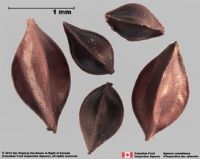 or drupedrupe:
or drupedrupe:
(indehiscent drupe) a fleshy, indehiscent fruit with one more hard pits enclosing seeds, derived from single, superior, simple or compound ovary; (dehiscent drupe) a fruit with a dry or fibrous to fleshy or leathery outer husk that early to tardily breaks apart (or opens), exposing one or more nutlike pits enclosing the seeds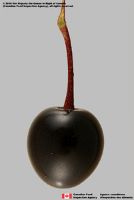 , 2–5 mm long, ellipsoidellipsoid:
, 2–5 mm long, ellipsoidellipsoid:
3D shape—elliptic
or ovoidovoid:
3D shape—ovate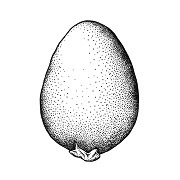 (acheneachene:
(acheneachene:
a dry, indehiscent, one-seeded fruit, with seed attached to pericarp at a single point, derived from a single, superior, simple or compound, one-loculed ovary ) or crescent-shapedcrescent-shaped:
) or crescent-shapedcrescent-shaped:
2D shape—arcuate or curved, broadest at the middle, and attenuate to acute ends; like a stylized outline of a first-quarter moon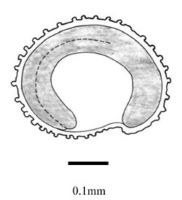 (drupedrupe:
(drupedrupe:
(indehiscent drupe) a fleshy, indehiscent fruit with one more hard pits enclosing seeds, derived from single, superior, simple or compound ovary; (dehiscent drupe) a fruit with a dry or fibrous to fleshy or leathery outer husk that early to tardily breaks apart (or opens), exposing one or more nutlike pits enclosing the seeds ), tereteterete:
), tereteterete:
approximately circular in cross section; width and thickness approximately equal
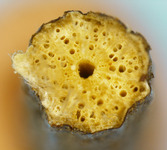 in transection, beakedbeak:
in transection, beakedbeak:
a usually firm, terminal appendage, sometimes tapered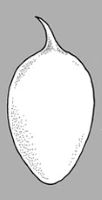 or not, with one seed. Pericarppericarp:
or not, with one seed. Pericarppericarp:
fruit wall or fruit coat
green or yellow, scariousscarious:
texture—dry, thin, membranous, non-green, more or less translucent
(acheneachene:
a dry, indehiscent, one-seeded fruit, with seed attached to pericarp at a single point, derived from a single, superior, simple or compound, one-loculed ovary ) or membranousmembranous:
) or membranousmembranous:
texture—extremely thin, pliable, and fairly tough
or fleshy (drupedrupe:
(indehiscent drupe) a fleshy, indehiscent fruit with one more hard pits enclosing seeds, derived from single, superior, simple or compound ovary; (dehiscent drupe) a fruit with a dry or fibrous to fleshy or leathery outer husk that early to tardily breaks apart (or opens), exposing one or more nutlike pits enclosing the seeds ), bristled in Phyllospadix. Endocarpendocarp:
), bristled in Phyllospadix. Endocarpendocarp:
the inner layer of the pericarp, if divided into layers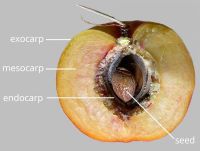 bonybony:
bonybony:
very hard and rather brittle, like bone
or fibrousfibrous:
texture—long, flexible threads, thicker than hairs, that densely cover and obscure the surface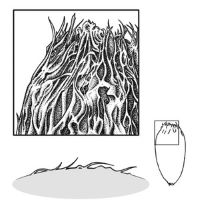 .
.
Seeds ovoidovoid:
3D shape—ovate or ellipsoidellipsoid:
or ellipsoidellipsoid:
3D shape—elliptic
, 1.4–3.2 mm long. Seed coat brown, shinyshiny:
uniformly reflecting a high proportion of incident light at all angles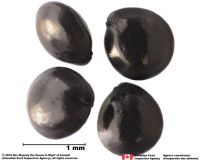 , thin, smooth, ribbedribbed:
, thin, smooth, ribbedribbed:
surface relief—wide, prominent, linear ridges that are generally rounded and longitudinally situated on the surface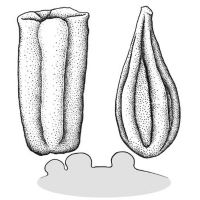 , or ridgedridged:
, or ridgedridged:
surface relief—raised, thick ridges, sharp edged or rounded, usually in a series that may cover the entire surface .
.
Embryo well developed, linearlinear:
(shape) long, narrow, and uniform in width; (of embryo) embryo is straight and much longer than wide , curvedcurved:
, curvedcurved:
(of embryo) linear embryo is curved into an arch or horseshoe with the ends far apart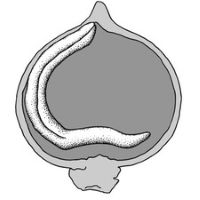 or coiledcoiled:
or coiledcoiled:
(of embryo) linear embryo is very long and bent to form a coil whereby one end of the embryo is on the outside and the other end near the middle of the seed , with enlarged hypocotylhypocotyl:
, with enlarged hypocotylhypocotyl:
portion of the embryonic axis below the cotyledons and above the radicle
, two adventitious root apicesapex:
the point farthest from the point of attachment, or the "tip" of an organ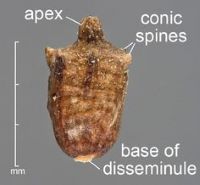 , and no radicle.
, and no radicle.
Endosperm absent.
| Fruit | |
| Type | acheneachene: a dry, indehiscent, one-seeded fruit, with seed attached to pericarp at a single point, derived from a single, superior, simple or compound, one-loculed ovary  , drupedrupe: , drupedrupe:(indehiscent drupe) a fleshy, indehiscent fruit with one more hard pits enclosing seeds, derived from single, superior, simple or compound ovary; (dehiscent drupe) a fruit with a dry or fibrous to fleshy or leathery outer husk that early to tardily breaks apart (or opens), exposing one or more nutlike pits enclosing the seeds  |
| Size range | 2–5 mm long |
| Shape(s) | ellipsoidellipsoid: 3D shape—elliptic , ovoidovoid: 3D shape—ovate  , crescent-shapedcrescent-shaped: , crescent-shapedcrescent-shaped:2D shape—arcuate or curved, broadest at the middle, and attenuate to acute ends; like a stylized outline of a first-quarter moon  |
| Texture | scariousscarious: texture—dry, thin, membranous, non-green, more or less translucent , membranousmembranous: texture—extremely thin, pliable, and fairly tough , fleshy |
| Surface relief | smooth, bristlybristly: having bristles or stiff hair or hair-like structures 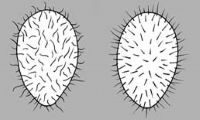 |
| Color(s) | green, yellow |
| Seed | |
| Size range | 1.4–3.2 mm long |
| Shape(s) | ovoidovoid: 3D shape—ovate  , ellipsoidellipsoid: , ellipsoidellipsoid:3D shape—elliptic |
| Surface relief | smooth, ribbedribbed: surface relief—wide, prominent, linear ridges that are generally rounded and longitudinally situated on the surface  , ridgedridged: , ridgedridged:surface relief—raised, thick ridges, sharp edged or rounded, usually in a series that may cover the entire surface  |
| Color(s) | brown |
| Other | |
| Embryo | well developed, linearlinear: (shape) long, narrow, and uniform in width; (of embryo) embryo is straight and much longer than wide  , curvedcurved: , curvedcurved:(of embryo) linear embryo is curved into an arch or horseshoe with the ends far apart  or coiledcoiled: or coiledcoiled:(of embryo) linear embryo is very long and bent to form a coil whereby one end of the embryo is on the outside and the other end near the middle of the seed  , with enlarged hypocotylhypocotyl: , with enlarged hypocotylhypocotyl:portion of the embryonic axis below the cotyledons and above the radicle , two adventitious root apicesapex: the point farthest from the point of attachment, or the "tip" of an organ  , and no radicleradicle: , and no radicleradicle:the embryonic root of the embryo  |
| Nutritive tissue | endosperm absent |
Temperate to subtropical regions.
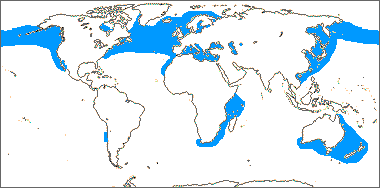
Distribution map courtesy of Angiosperm Phylogeny Website.
Baskin and Baskin 2021Baskin and Baskin 2021:
Baskin C and Baskin J. 2021. Relationship of the lateral embryo (in grasses) to other monocot embryos: A status up-grade. Seed Science Research 31 (3): 199-210. doi:10.1017/S0960258521000209; Dahlgren et al. 1985Dahlgren et al. 1985:
Dahlgren RMT, Clifford HT, and Yeo PF. 1985. The families of the monocotyledons: structure, evolution, and taxonomy. Springer-Verlag, Berlin. 520 pp.; Flora of Australia 2021+Flora of Australia 2021+:
Flora of Australia. Australian Biological Resources Study, Canberra. Accessed January 2021–March 2024. URL: http://www.ausflora.org.au; Kirkbride et al. 2006Kirkbride et al. 2006:
Kirkbride JH, Jr, Gunn CR, and Dallwitz MJ. 2006. Family guide for fruits and seeds, vers. 1.0. Accessed September 2020-January 2022. URL: https://nt.ars-grin.gov/seedsfruits/keys/frsdfam/index.cfm .; Kubitzki et al. 1990+Kubitzki et al. 1990+:
Kubitzki K et al., eds. 1990+. The families and genera of vascular plants. 7+ vols. Berlin etc.; Stevenson and Loconte 1995Stevenson and Loconte 1995:
Stevenson DW and Loconte H. 1995. A cladistic analysis of monocot families. In: Rudall PJ, Cribb PJ, Cutler DF, and Humphries CJ, eds. Monocotyledons: Systematics and Evolution. Royal Botanic Gardens, Kew.; Watson and Dallwitz 1992+Watson and Dallwitz 1992+:
Watson L and Dallwitz MJ. 1992+. The families of flowering plants: descriptions, illustrations, identification, and information retrieval. Version: 6th Accessed September 2020-September 2022. URL: delta-intkey.com; Zhengyi et al. 2004+Zhengyi et al. 2004+:
Zhengyi W, Raven PH, and Deyuan H. 2004+. Flora of China [online]. 25 vols. Science Press, Beijing China & Missouri Botanical Garden, St. Louis USA. Accessed January–March 2024. http://flora.huh.harvard.edu/china/
*The number of genera and species is based on Christenhusz and Byng 2016Christenhusz and Byng 2016:
Christenhusz MJM and Byng JW. 2016. The number of known plant species in the world and its annual increase. Phytotaxa 261 (3): 201-217. https://doi.org/10.11646/phytotaxa.261.3.1, which may differ from the number of genera in GRIN-Global.